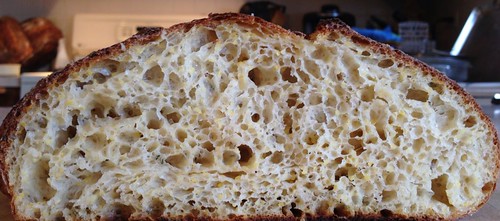February 6, 2013 - 10:16am

Polenta Rosemary Sourdough
Formula:
KAF-Lancelot 100%
Water 77%
Levain (100% hydration) 25%
Salt 2%
Polenta 60%
3T Rosemary
4 hour bulk rise.
2 hour counter proof
16 hour retard @ 39 degrees Fahrenheit
The crumb was extremely moist, sweet, and slightly sour. The crust was thin and crisp. I was hoping for more of an oven spring upward as oppose to sideways, but given the amount of polenta and water added it just didn't happen. Still one of my favorites.




Comments
even if there were no polenta in the bread. With the polenta, it's stunning! Well done, dylemma.
Paul
What he (PMc) said. Stunning crumb, polenta or no. Nice baking!
Tom
Might I ask what you put into your polenta? Was is strictly water, salt, and cornmeal or did you add any stock to it or even dairy?
Scott
The polenta is a 2:1 water to polenta ratio. Mix boiling water, polenta and a pinch of salt in a bowl and soak for 3 hours.
Thanks!
and out. We just love boldly baked bread and your crumb is abot as good as you could expect with polenta in it. I am trying to imagine what it tastes like but will have to bake one up and see. It's got to be tasty!
Nice Baking
Your bread is stunning. I just clicked your profile and noticed you have been a member for 5 years but this is your first post. So welcome, if I can say that, as I've only been a member for 3 years. -Varda
Beautiful looking open and moist crumb. I have use cooked polenta with cheese in my bread before and love the texture and moistness it adds to the bread.
Great job for sure.
Ian
very beautiful bread and crumb!!! no doubt it is delicious too.
evonlim
Thanks everyone for the kind words! Years of reading everyone's posts and blogs has helped me get to this point. Thanks again.
-Derek
Very nice sourdough loaf. Sounds like a winner to me. Did you do any stretch and folds during the 4 hour bulk rise?
John
I did 2 S&F in each of the first and second hour, and 1 in the third hour.
And a sensational open crumb! Surprised you managed this with a polenta bread. Marked down to try! Thank you.
Cheers
Ross
Pardon my ignorance, but how to read the percentages here?
> KAF-Lancelot 100%
This is 100% flour, I understand
>Water 77%
> Levain (100% hydration) 25%
> Salt 2%
77% of what? 25% of what? 2% of what? 77+25+2=104% (!!)
Polenta 60%
Again, of what?
I think, if you write, for example, 7 cups flour, 1 cup polenta, 1Tsp salt it would be much more clear, but maybe it's just me.
Jerry94087,
The percentages always relate back to the total amount of flour(s) used. So, "Water 77%" means that the ratio of flour to water is 100:77. "Levain (100% hydration) 25%" means that the levain is made of a 1:1 ratio of flour and water and the total weight of the levain is 25% of the total flour weight.
The use of volume measures (like teaspoons and cups) are what Americans are most accustomed to, but volume measures can be wildly inaccurate. Weighing the ingredients (whether in ounces or grams) is much more accurate. Providing the percentages and ratios of ingredients allows for the same dough formula to scaled up or down, for larger or smaller quantities. (And for grad student bakers like myself, the volume of dough often simply depends on how much flour you've got until the next stipend or adjuncting paycheck comes in. With bakers percentages I can make due with large or small flour stockpiles!)
So, you will not come up with 100% by adding all of the percentages together, since each ingredient is always related directly back to the amount of flour used. If you had 10 different ingredients (as you might with a loaf with whole grains, nuts, and dried fruit), you might come up with a lot more than 100% by adding all of the percentages together, because the ratio is always an individual one between ingredient and flour, not between the individual ingredients and the total dough.
I hope this clarifies things,
Scott
Awesome loaf! What size banneton and loaf was that?
Thanks!
Steve
I used a 17 inch banneton, and the dough weight was 1.5kg.
http://www.sfbi.com/17-oval-nonremovable-lined-baskets-detail